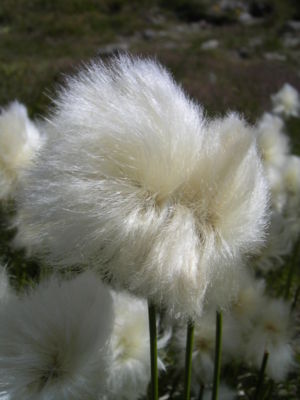Scheuchzer's cotton grass
| Scheuchzer's cotton grass | ||||||||||||
|---|---|---|---|---|---|---|---|---|---|---|---|---|

Scheuchzer's cotton-grass ( Eriophorum scheuchzeri ) |
||||||||||||
| Systematics | ||||||||||||
|
||||||||||||
| Scientific name | ||||||||||||
| Eriophorum Scheuchzeri | ||||||||||||
| Hoppe |
The eriophorum scheuchzeri ( Eriophorum scheuchzeri ), also Alpine Wollgras called, is a plant from the genus Wollgräser ( Eriophorum ) within the family of Cyperaceae (Cyperaceae). With its long foothills that penetrate far into the water, it contributes significantly to the silting up of alpine waters. The specific epithet Scheuchzeri honors the natural scientist Johann Jakob Scheuchzer .
description

Scheuchzer's cottongrass grows as a perennial herbaceous plant and reaches heights of 10 to 40 centimeters. It forms very long red-brown runners . The simple leaf blades are short with a smooth edge.
The flowering period extends from June to September.
The chromosome number of the species is 2n = 58.
ecology
Scheuchzer's cottongrass is a hemicryptophyte .
Occurrence
The distribution area of Scheuchzer's cottongrass stretches from Europe to the western Himalayas and Mongolia and includes subarctic and subalpine North America. Scheuchzer's cottongrass is rarely found, mostly in smaller and occasionally in larger stands, especially in the central chains of the Alps with crystalline rock. In larger areas of Central Europe it is completely absent.
Scheuchzer's cottongrass occurs at altitudes of 1500 to 2000 meters in the subalpine to alpine altitudes . In the Allgäu Alps in the Tyrolean part near the Hermann-von-Barth-Hütte it rises up to 2100 m above sea level.
It grows on wet, more or less nutrient-poor peat . Scheuchzer's cottongrass thrives in flat moors, muddy ponds, ditches and lakes and silting areas of stagnant water. It thrives best on not too base-like, peaty or raw humus- containing , wet soils . Where it forms larger stands on high alpine lakes with flat banks, it contributes significantly to their silting up . It is a character species of the Eriophoretum Scheuchzeri from the association Caricion fuscae.
Individual evidence
- ↑ a b Erich Oberdorfer : Plant-sociological excursion flora for Germany and neighboring areas . 8th edition. Stuttgart, Verlag Eugen Ulmer, 2001. ISBN 3-8001-3131-5 . Page 158.
- ↑ Rafaël Govaerts (Ed.): Eriophorum Scheuchzeri. In: World Checklist of Selected Plant Families (WCSP) - The Board of Trustees of the Royal Botanic Gardens, Kew . Retrieved October 29, 2016.
- ↑ a b Dietmar Aichele, Heinz-Werner Schwegler: Our grasses. Sweet grasses, sour grasses, rushes . 11th edition. Kosmos, Stuttgart 1998, ISBN 3-440-07613-X .
- ↑ a b Dietmar Aichele, Heinz-Werner Schwegler: The flowering plants of Central Europe . 2nd Edition. tape 5 : Swan flowers to duckweed plants . Franckh-Kosmos, Stuttgart 2000, ISBN 3-440-08048-X .
- ↑ Erhard Dörr, Wolfgang Lippert : Flora of the Allgäu and its surroundings. Volume 1, IHW, Eching 2001, ISBN 3-930167-50-6 , p. 219.
Web links
- Scheuchzer's cotton grass. In: FloraWeb.de.
- Scheuchzer's cotton grass . In: BiolFlor, the database of biological-ecological characteristics of the flora of Germany.
- Profile and distribution map for Bavaria . In: Botanical Information Hub of Bavaria .
- Eriophorum scheuchzeri Hoppe, map for distribution in Switzerland In: Info Flora , the national data and information center for Swiss flora .
- Distribution in the northern hemisphere from: Eric Hultén , Magnus Fries: Atlas of North European vascular plants 1986, ISBN 3-87429-263-0 at Den virtuella floran (swed.)
- Thomas Meyer: Data sheet with identification key and photos at Flora-de: Flora von Deutschland (old name of the website: Flowers in Swabia )
- Data sheet with photos.
- Characteristics.